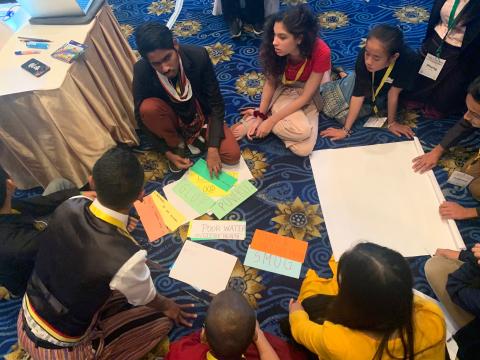Three crucial steps to children influencing global decisions
Anne-Marie considers how far the world has come in inviting children to speak to the decision-making table, but proposes three next steps to getting them a seat there.
Anne-Marie Vuignier, Advocacy and External Engagement Officer, World Vision.
This year marks 32 years since world leaders agreed on a Convention on the Rights of the Child (CRC). That moment three decades ago was a breakthrough for children, because they were finally acknowledged as active subjects, entitled to contribute to the realisation of their rights, not just passive recipients of adult protection.
The Convention is clear: children have the right to freely express their views on all matters and decisions that affect them, and to have those views taken into account at all levels of society. It is the right of every child, without exception. (Article 12 of CRC and General Comment 12 ).
Last year, the CRC Committee achieved another significant milestone by issuing a Child Safeguarding Procedure that sets a precedent for the United Nations. This was previously a missing piece as the lack of official UN safeguards was often an excuse not to support the involvement of children at the UN level.
Their voice, their right!
The recognition that children are partners in intergovernmental spaces and decision-making processes is on the increase. Even though not all Member States agree on that, the obstacles to it becoming standard are increasingly falling.
World Vision, together with its partners, has been instrumental in helping to bring about that change. We brought child participation to the higher level of the Universal Periodic Review (UPR) by facilitating the first ever child-led UPR submission in 2010 (a review of Lebanon). More recently, we have seen young advocates, many of them collaborating with a new youth platform run by World Vision, taking the floor; not just in side events and webinars but during official sessions of the Human Rights Council, the General Assembly, and the Security Council.
The young people are vocal, very articulate, they have solutions and ideas and they are fully claiming their right to influence UN mechanisms.
This month in Glasgow, during COP26, children and young people were more visible than ever, they were the ones putting pressure on States and shaping the discourse. Again, we should celebrate that they were not only present in the streets and in panels, but also in negotiations.
As much as we should celebrate all the spaces that are now available for children on this 32nd anniversary, we should recognise that there is still work to do. Dola, a young leader from Bangladesh tells us: “I want to communicate directly with the UN Committee Members and other senior adults in the UN to hear our voices and ideas, but it is very hard to reach them.”
We have a duty towards her and other children and young people, to do all that is possible to facilitate their participation in global processes and make it more sustainable and systematic, moving from occasional participation to a dedicated space at the table.
3 steps for children to influence global decision making:
In order for children to meaningfully engage in global spaces such as the United Nations, we all need to work and advocate towards:
- Developing dedicated platforms and spaces for them to participate. Have dedicated child and youth forums and ensure these are fully integrated in global meetings and mechanisms;
- Making sure children have access to child-friendly versions of documents, trainings and information necessary for their engagement;
- Institutionalising their participation to ensure they are not only able to speak, but their voices are heard and taken into account in global decisions.
This will not happen by accident. It takes intentionality, effort and, of course, requires adequate funding and resources to build this into organisational capacity at all levels. Nevertheless, achieving this is more important than ever. World Vision’s recent reports [1] have demonstrated the extent to which children are impacted by global crises such as COVID-19, as well as hunger and climate change.
We have to make sure they are given the proper space – across all levels: local, regional and global - to shape the future.
Anne-Marie Vuignier is an Advocacy and External Engagement Officer with World Vision. Her main engagement is with UN and UN related organisations in Geneva. She has over 10 years of experience in promoting Human Rights and Child Rights at the UN and EU. Before joining World Vision in February 2020 she worked for 15 year at the World Council of Churches for a programme on Palestine and Israel focusing on the protection of vulnerable children and communities. Her main interest is to bring the voices of the local communities and children to the highest level of decision making in Geneva, in particular on issues pertaining to violence against children.
[1] COVID-19 Aftershocks: Out of time, COVID-19 Aftershocks: Secondary impacts threaten more children's lives than disease itself Aftershock, UNMASKING II: Childhood Lost, Pacific Aftershocks: Unmasking the impact of COVID-19 on lives and livelihoods in the Pacific and Timor-Leste.
